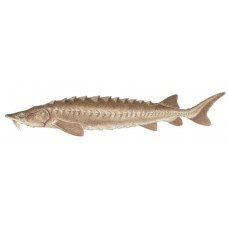Latin name
Acipenser fulvescens
Other names
Sturgeon, red sturgeon, rock sturgeon; Cree: nameo, nemeo.
Identification
Lake sturgeon are somewhat torpedo-shaped, and the upper lobe of the caudal fin is longer than the lower lobe. The beginning of the anal fin is posterior to the beginning of the dorsal fin. The fish has an olive-brown coloration, and the shields (bony scales) on the back and sides are the same color as the skin. There are 9 to 17 scales on the back, 29 to 42 scales on the sides, and 25 to 30 anal rays. There are 4 spines on the underside of the mouth.
Distribution
Lake sturgeon are found in the St. Lawrence Seaway and the Great Lakes. They occur in the Hudson Bay and Mississippi River basins from Quebec to Alberta and south to Alabama and Louisiana, including Lake Winnipeg, Manitoba and its tributaries. They are rare in the Ohio and middle Mississippi River basins. Lake sturgeon numbers throughout this range are a fraction of what they once were, and the species is absent from some parts of its former range. Some stocking efforts are underway.
Habitat
Lake sturgeon are predominantly freshwater fish found in large lakes and rivers, usually 15 to 30 feet deep. They live on muddy, sandy, or gravelly bottoms, but can (rarely) be found in brackish water.
Size
Lake sturgeon can reach 9 feet in length and weigh between 200 and 300 pounds, although 100-pound fish today are extremely large, and most are in the 40 pound range and about 4 feet long. The life span of the lake sturgeon varies according to different data, but it was once thought to be 80 to 100 years or more. A specimen caught in 1952 was thought to be 152 years old, but older specimens from the modern era were only 38 years old.
Life history and Behavior
Males mature at 14 to 16 years of age and females mature at 24 to 26 years of age. As adults, lake sturgeon migrate up to 125 miles to spawn. During spawning, they sometimes leap out of the water and fall with a loud splash. Spawning fish migrate in the fall and then overwinter in their spawning grounds. Spawning peaks in April with temperatures between 48° and 58°F. Secondary spawning probably follows in May. They spawn on gravel, under dams or other obstructions, in fast, shallow water, sometimes in an exciting commotion accompanied by flapping, rolling, and jumping. Six to eight males spawn with each female. They spread eggs and sperm over a large substrate, such as rocks, and the eggs adhere to the substrate.
Food and feeding habits
Lake sturgeon feed in freshwater, usually on the bottom. In Lake Winnebago, juvenile lake sturgeon feed primarily on midges, larvae of some water phase moths, and water fleas. Mayfly nymphs and mollusks are also important components of the lake sturgeon diet. The amount of fish consumed varies by habitat, ranging from little or no fish to 25 percent of the diet.
Reproduction
Eggs hatch 8-14 days after fertilization and drift downstream to calmer waters overnight. As with most sturgeon, early growth is rapid. Mature females spawn only once every few years.
| Classification | |
| Phylum | Chordata |
| Class | Actinopterygii |
| Squad | Acipenseriformes |
| Family | Acipenseridae |
| Genus | Acipenser |
| Species | A. fulvescens |
| Features | |
| Conservation status | Endangered |
| Habitat | Bottom |
| Life span, years | 150 |
| Maximum body weight, kg | 108 |
| Maximum length, cm | 220 |
| Sailing speed, m/s | No information |
| Threat to people | Edible |
| Way of eating | Bentophage |



